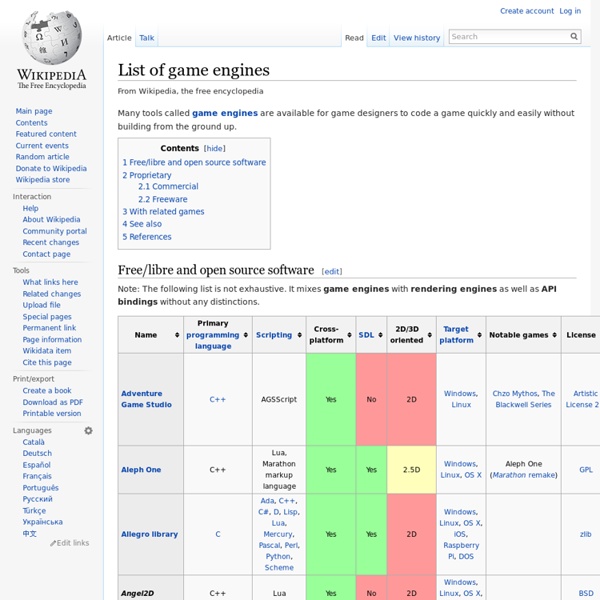Qube Software
start [Godot]
Note: Please do not change the guest account password! Welcome to the Godot Engine documentation center. The aim of these pages is to provide centralized access to all documentation-related materials. Latest Build:Build Date: 2014-04-14_22-44-41 Executables: NOTICE: iOS deployment targety will be available the coming weeks. NOTICE: Godot requires at least OpenGL 2.1 support to run the editor, older Intel GPUs might not work. NOTICE: if opening demos from the project manager does not work under Linux, decompress the binary with the command “upx -d godot_x11.64” Demos: Export Templates: Basic (Step by Step) Advanced Memory Memory model and administration. Editor Plug-Ins Class List Languages GDScript Built-in, simple, flexible and efficient scripting language.Squirrel Optional, more complex scripting language. Import Export PC Exporting for PC (Mac, Windows, Linux).NaCL Exporting for Google Native Client.HTML5 Exporting for HTML5 (using asm.js).Consoles Exporting for consoles (PS3, PSVita, etc).
PhyreEngine
PhyreEngine is a free to use game engine from Sony Computer Entertainment compatible with PC, PSP, PlayStation Vita, PlayStation 3 and PlayStation 4. PhyreEngine had been adopted by dozens of game studios in over 90 published titles. PhyreEngine is distributed as an installable package that includes both full source code and PC Windows tools, provided under its own flexible use license that allows any PS3 game developer, publisher or Tools & Middleware company to create software based partly or fully on PhyreEngine on any platform. History[edit] PhyreEngine was launched during GDC 2008[1] with new features (including Deferred rendering) being showcased during GDC 2009.[3] Version 2.40, released in March 2009, included a new “foliage rendering” system that provides tools and technology to render ultra-realistic trees and plants to be easily integrated into games.[4] A PSP version of the engine was announced by Sony at GDC 2010.[4] Partial List of Studios and Games that use PhyreEngine[edit]
Beginning Game Programming for Teens with Python
If you're new here, you may want to subscribe to my RSS feed or follow me on Twitter. Thanks for visiting! Learn how to make a simple game with Python! This is a post by Tutorial Team Member Julian Meyer, a 13-year-old python developer. You can find him on Google+ and Twitter. Have you ever wondered how video games are created? In this tutorial, you’ll create a simple game called Bunnies and Badgers, where the hero, the bunny, has to defend a castle against an attacking horde of badgers. To write this game, you’ll use Python. Python is a computer programming language. If you are new to Python, before you begin check out this book: Think Python: How to Think Like a Computer Scientist. Then dive back here and get ready – there’s a war coming on between the bunnies and the badgers. Getting Started: Installing Python If you want to try this tutorial on a Windows PC, you need to install Python. If you are on a Mac, you already have Python installed! Running Python Code from File To: Wow!
Sony Computer Entertainment Europe - R&D: Home Page
oakes/play-clj
Game Physics Simulation
Gabriel Gambetta - Pathfinding Demystified (Part I): Introduction
Part I - Part II - Part III - Part IV Introduction Pathfinding is one of these topics that usualy baffles game developers. The objective of this series of articles is to explain pathfinding in general and A* in particular in a very clear and accessible way, and put an end to the misconception that it’s a difficult topic. Note that the focus is on pathfinding for games; unlike a more academic approach, we’ll just skip search algorithms such as Depth-First or Breadth-First. This first article explains the very basic concepts of pathfinding. A Simple Setup Although you’ll be able to apply these concepts to arbitrarily complex 3D environments, let’s start with an extremely simple setup: a 5 x 5 square grid. The very first thing we do is to represent this environment as a graph. Each node represents a “state” your character can be in. Now let’s add the edges. If you can get from A to B, we say B is “adjacent” to A. An Example Say we want to go from A to T. Suppose we walk to B. explored = []
Scaleform - home | scaleform



